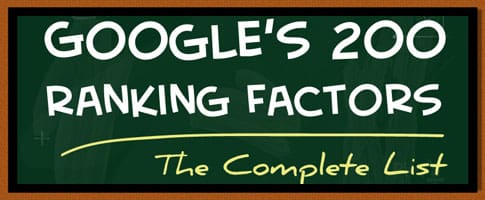SEO In Trinidad & Tobago Part 4: Google's 200 Search Ranking Factors
I’ve pre-empted my planned content for Part 4 to bring you this absolutely priceless infographic, billed as ‘Google’s 200 Ranking Factors: The Complete List’ that explains 200 ways Google is judging your website right now. As we say in Trini ‘Wha more yuh want?’
It’s a dizzying list, some you’ll be able to understand and some not. These are just the factors, meaning you have to actually apply them to your website. By ‘you’, I don’t mean you as there’s a lot of website jargon that may sound like Spanish to you. Why not Greek? Because I’m sure you can still pick some sense out of Spanish, but Greek…well is pure Greek. Make sense?
200 Ways Google Ranks your website
I’m not going write the entire list but put the list into a bite size perspective for you. The list is divided into discrete areas and I highlighted the main factors:
1. Domain Factors
Domain factors identified are:
- Domain Age
- Domain Registration Length
- Keyword in the domain
- Private Domains
- Country domain extension
I want to draw attention to point 3, as many of my clients are register for a year at a time and only renew for an additional year.
2. Page Level Factors
- Things to consider when creating your site pages (or when I am) and adding their content:
- Keyword in Title Tag
- Keyword in description
- Keyword in H1 tag (I’ll explain)
- Keyword as frequently used phrase in content
- Content length
- Image optimization
- Magnitude of content updates (i.e updating site content)
- Keywords on other heading tags
- Number of internal links pointing to a page
- WordPress Tags (see at bottom of my site)
- Multimedia- Use of videos
- Bulleted and numbered lists (You see I use these all the time)
- User friendly layout
H1, H2 etc are called Heading Tags. In this article the ‘200 ways…’ I have above are H2 and the numbered factors after I have as H3. You see them as larger and highlighted/bold fonts visually but in the code end, they have specific uses for content layout. They guide Google on how the content is organized.
Little or no content updates are a common practice for websites in Trinidad & Tobago as Trini site owners seem to have a ‘set it and forget it’ mentality. WordPress as a content management system makes it easy to do minor updates, post blog articles, add portfolio projects which is fine, and I often train my clients to use the WordPress dashboard, but if it’s search engine optimization you’re looking for it’s not as easy to do yourself.
Many pages in the Forward Multimedia website have been re-written this year alone. I’ve added new pages and updated a few (Payment Processing, Website Design in T&T Overview, Online Marketing in T&T, Starting an E-Commerce Website in T&T). Did you notice that I’m applying some of these factors right here in this article?
3. Site Level Factors
Now the site level:
- Use of Google Analytics and Webmaster Tools (installed on all client’s sites)
- Contact page (with full info- I see many Trini sites with just an email or form)
- Site Updates (the freshness factor)
- Number of pages (that’s why I call my Starter Package Phase 1, it’s not the end)
- Presence of sitemap
- SSL Certificates on E-Commerce sites
- Breadcrumb Navigation (most themes have these as standard)
- User reviews/Site reputation (you trust me don’t you)
4. Back Link Factors
This is not a widely known factor in Trini site owners and it’s a really big deal. Sites that link to your site are treated as a ‘vote’ for your site’s credibility, especially when it’s a prominent site that links to you.
- Authority of linking domain (what I just said)
- Diversity of link types
- Linking domain age
- Social shares of referring page
- Contextual links (links inside the page’s content that links to you)
- Linking domain relevancy (you’re in construction and a you get a link from a heavy equipment site)
- Word count of linking content
5. User Interaction
Trinis are searching everyday looking for sites that are not there. When they do find a site many leave as quickly as they came (Bounce Rate). If you designed your site right, they stay and browse and hopefully answer your Call to Action. What gives your site relevance in search rankings are:
- Organic Click Through rate for a keyword (my keyword ‘website design trinidad’ puts me mostly at the top of Google; I get a boost for that keyword when people actually click my site.
- Direct Traffic (sites with high direct traffic are perceived as quality sites)
- Repeat traffic
- Bounce Rate
- Time on site
- Number of comments (it’s hard to get Trinis to comment)
6. Social Signals
There’s a reason Trinis are crazy about Facebook and you should definitely have a Facebook strategy. We aren’t crazy about Twitter yet but we’re getting there.
- Number of Facebook Likes
- Number of tweets
- Facebook shares
- Pinterest Pins (Pinterest is also now catching on)
- Number of Google +1’s
- Verified Google authorship
Conclusion
Like I said, we still have to apply techniques, either by way of writing the content, writing meta descriptions, encouraging linking and sharing etc. The ultimate goal is RELEVANCY, when someone searches your keywords or keyphrases, Google returns your site. It’s like you saying “I’m search for this” and Google says “You’re going to find it here” which is match made in heaven isn’t it?
Here’s the link to the infographic:




Comments
No comment yet.